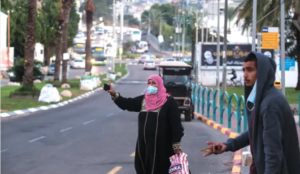Scarce public transport still plagues Israeli Arab towns, survey finds

Waiting for a bus in Arara, northern Israel
Asnat Nir reports in Haaretz on 24 February 2021:
Y. lives in a hamlet next to Arara, a town in Wadi Ara in Israel’s north. Before the onset of the coronavirus pandemic, he would spend no less than three hours a day driving back and forth on Route 6 to his job in Jerusalem. “The drive on Route 6 takes just 30 minutes, but it takes another hour to get from Route 6 to my village because of traffic jams,” he says. “Without the tie-ups, it would take 12 minutes.”
Travelling Route 6 isn’t cheap. Y. spends 600 shekels ($185) a month on tolls that he doesn’t get back from his employer as commuting expenses. “I tried once to avoid Route 6,” he says. “I left at 5:30 in the morning and got to work at 9.”
And what about public transportation? It’s not a real alternative, Y. says. “It’s not that there isn’t any, but it’s very thin – the number of lines and the frequency isn’t enough.”
As he explains it, “When I began working in Jerusalem 15 years ago, there was just one line that ran from Wadi Ara to Jerusalem – the 955. Since then, they’ve added two others, but they stop only in Umm al-Fahm and nowhere else. So the 955 is still the only option and it leaves only twice in the morning, at 6:15 and 9:00, and returns twice in the afternoon.”
Y.’s frustration stands in sharp contrast to the claims of the government, which says there’s been a big improvement in public transit service to Arab communities in the last few years. Resolution 922, approved by the cabinet in 2015, launched a major undertaken to develop Arabs towns in a host of different areas, including public transportation.
Expected to be completed in 2020 but now extended another year, the program aims to close the gaps in the level of government assistance between Jewish and Arab communities. In the realm of public transportation, the goal was to increase service by 40% or spend 100 million shekels annually, whichever was greater, until there is parity between Jewish and Arab areas.
When you look at the numbers, it appears that there has been a big improvement. The Transportation Ministry has reached 78% of its targets. But a study conducted by the nonprofit organization Sikkuy – The Association for the Advancement of Civic Equality asserts that the methodology the government is using is wrong and so are its results.
The government uses metrics such as the number of bus stops per 1,000 residents, number of trips on bus lines running to Arab towns and the number of destinations they reach. The Social Equality Ministry is in charge of monitoring.
The Sikkuy study says the government’s figures present a distorted picture because they measure public transportation in Arab communities without comparing it to what is available in Jewish ones. The gaps between the two remain unaddressed, the authors say.
The gap, noted the report, “adversely affects the ability of Arab society to access the job market, higher education and reach essential services that mostly are offered in nearby Jewish towns.”
Comparing public transportation between demographically equivalent Jewish and Arab communities, Sikkuy found when the survey was made in July 2019, for example, that the number of weekly trips and number of destinations is 1.5 times higher in Jewish localities and the average number of lines serving them is 2.5 times more.
The biggest gaps were service inside cities. For instance, Baka al-Garbiyeh, an Arab city of 30,000, is served by a single city bus route. In Gedera, a Jewish town of 27,000, there are three routes. In Arara, with a population of 25,000, there’s no intracity service at all. In Migdal Haemek, which is about the same size there are nine.
Service frequency also differed between Jewish and Arab communities. Afula had not only four times as many routes as Umm al-Fahm but 3.5 times as much as service.
The money that the state has allocated for public transportation hasn’t been fully utilized for technical reasons, said Sikkuy’s Roi Barak, for instance, a shortage of bus drivers. Over five years, only 295 million of the 500 million shekels budgeted was actually spent. “When the state is supposed to spend 100 million shekels a year (something that in practice hasn’t happened) it’s important to verify targets. We know you can’t rectify a gap 70 years in the making in five years – it requires a long-term plan,” said Barak.
The government did, in fact, set longer-term goals but has no program to realize them.
This article is reproduced in its entirety.
